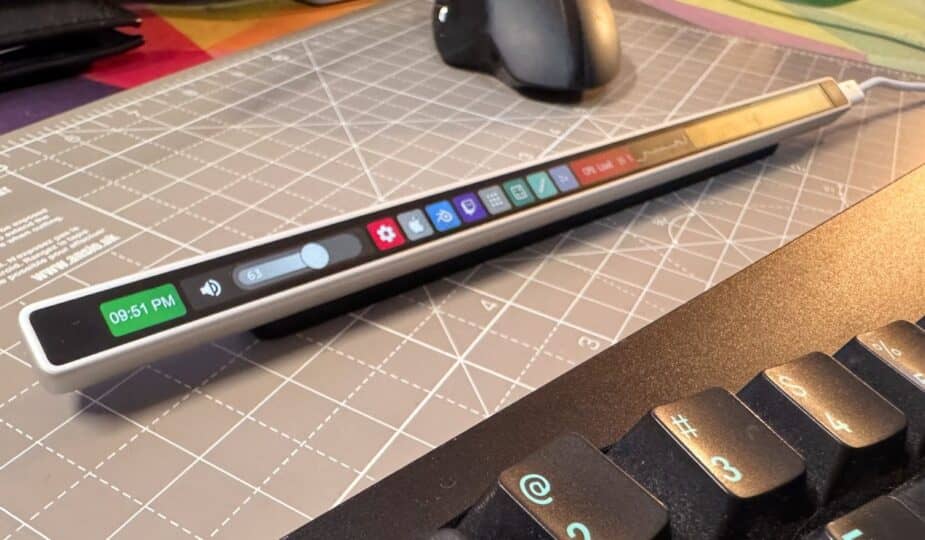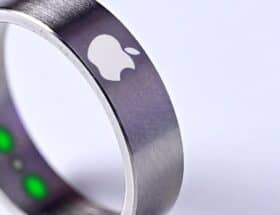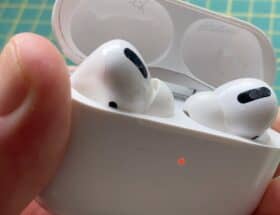Flexbar Review: Designed to Be Close to Your Keyboard and Your Fingers
 0 Facebook x.com Reddit Bluesky
0 Facebook x.com Reddit Bluesky
Flexbar
3.0/5 Buy
Last updated 1 hour ago
Flexbar is Apple's Touch Bar replacement that could rival Stream Deck if the software is finally polished.
The Touch Bar was a feature of the MacBook Pro keyboard that promised productivity. By giving users the ability to tap a row of context-sensitive buttons that would launch shortcuts or change settings, they could potentially do more without having to navigate menus or remember key combinations.
While the feature had potential, it was often derided and eventually replaced with a row of physical function keys after the death of the 13-inch MacBook Pro.
Consumers no longer have the option to use the Touch Bar on the current generation of Apple hardware, and instead have to look elsewhere if they want something similar. The Stream Deck is an obvious and well-tested option, but if you want an interface that’s much closer in concept to the Touch Bar, you should look to the Flexbar.
Created by Eniac, the Flexbar is a thin OLED display that provides a set of software buttons and controls for working with your Mac and its apps. By touching the screen, you can run keyboard shortcuts, macros, or otherwise control your connected Mac, all from a panel designed to fit above the keyboard, just like the original Touch Bar.
While it won’t necessarily offer all the features of Apple’s Touch Bar, it does offer a lot of what its predecessor promised.
Flexbar Review – Design
The Flexbar is basically an OLED display in an aluminum alloy casing. It’s a thin strip of display, and at 10.8 inches long, 0.6 inches wide, and 0.3 inches thick, it’s almost as long as the Magic Keyboard.
The aluminum alloy casing won’t get in the way when surrounded by Apple hardware, so it should fit easily into most Mac setups.
The heart of the device is a 2K AMOLED screen with a resolution of 2170 by 60 pixels. It’s obviously not intended to be used as an actual display for content, but it’s large enough that tappable elements are visible.
Flexbar review: The display is bright and easy to read.
It's a touchscreen, but there are also two black elements on the ends that don't have a display. While they're not used as part of the visible display, they still have uses, such as opening a small interface drawer or being the default back button.
It's also very light at 71.7 grams (2.5 ounces), so it's easy to carry around with your MacBook Pro. That is, if you can fit it into a pocket of the right size in your bag.
When used as intended, the top of the MacBook Pro's keyboard requires you to lift your fingers about half an inch to press its elements. When used on a desktop Mac placed on a table behind the keyboard, it will sit much more level with the keys.
Flexbar review: It's a long touchscreen display similar to the Touch Bar
When used on its own, its smooth base means it can easily slide around your desk if you’re not careful. Eniac includes some pads to increase grip, but there’s also a magnetic stand included in the box.
The wedge-shaped stand sticks firmly to the Flexbar and tilts the display towards the user, making it easier to see the screen. This does raise the Flexbar higher, so it’s harder to reach on a MacBook Pro, but it’s significantly more useful for desktop users.
Flexbar review: Included magnetic wedge helps tilt the Flexbar
Connecting the Flexbar to your Mac is via a USB-C cable, and a braided cable is included in the box. It plugs into one end of the Flexbar, carrying data and power.
This might be an issue for people wanting a wireless desktop, but it would be hard to imagine hiding a battery in this case without making it thicker.
By default, you connect to the USB-C port on the right side of the display, but you can flip it over and change the settings so that it works with the port on the left, too.
The Flexbar’s light weight does create an issue with cable snagging, making it very easy to move the bar itself. This isn’t as big of an issue when using the stand for the extra weight, but it’s still something to keep in mind when using it.
Flexbar Review – Designer
While the hardware itself is half the equation, the other is the software. Flexbar Designer is the application you use to add all the soft buttons and elements to the Flexbar itself.
Given the Flexbar view, users can add different types of buttons that perform different tasks. The most obvious are buttons used to run a macro or to perform keystrokes for you, such as a button that places basic HTML code in a text field.
Other types include media controls, hardware controls like your Mac's screen brightness or volume controls, and buttons for opening web pages or apps.
All buttons can be easily positioned and have a lot of control over how each button looks. This can include making the button wider or narrower, border styles, font styles, and the arrangement of elements within the button itself.
These aren't just buttons. For example, you can customize the volume slider so you can set the exact volume percentage you want.
Not everything has to be interactive, as you can also use Flexbar as a data display. There are options to view metrics like CPU load or RAM usage, which are displayed as real-time updated graphs.
Flexbar overview: Flexbar Designer is used to customize menus from your Mac.
You're not limited to just a single screen of icons and elements either, as you can define pages. Each page can contain multiple buttons, which can make it much easier to group keyboard shortcuts based on the app you're currently using.
In our short time with Flexbar, we were able to set up a keyboard shortcut page for Blender and Twitch. In the demo layout that came pre-installed on Flexbar, it included pages for Adobe apps, games including Minecraft, OBS, and pages of canned phrases and statements for chats.
Flexbar can organize up to 14 levels of nested pages, so you can easily customize groups of icons into larger groups. For example, pages for Adobe Premiere, Lightroom, and Photoshop could be nested within a common Adobe page, which could itself be nested within a Work nest.
The guide explains that you can pin a page to a window so that it appears on the Flexbar as soon as that window or application has focus on the main desktop. This can be extremely useful if set up correctly.
While Eniac has put some effort into making the process of adding items to the Flexbar display clear, there is still a lot of work that needs to be done for the user. It would be much easier for the user to get started with Flexbar, for example by providing predefined collections of default shortcuts for applications that users could add.
This is not currently available, but may be available in the future.
As a Kickstarter project, the team is still working to put all the pieces together, including creating the software needed to make Flexbar work. Since a preview of the software was shared with AppleInsider before Flexbar was replaced, it is in a usable state, although not fully fleshed out.
Since it is software, there is always the prospect of expanding its features to make it much more user-friendly. Indeed, there are already promises of elements in development to achieve this goal.
A plugin system will allow developers to add Flexbar functionality via an API. This provides the opportunity for deeper integration with applications and possibly more control.
A plugin marketplace will also be launched, which in turn will make it easier for users to add apps to the Flexbar interface. It’s easy to imagine installing a plugin and automatically populating the page with the appropriate buttons and controls for the app.
However, these are still work-in-progress features that won’t be available at first. The plugin system and marketplace are expected to launch in Q2 2025.
They’re not available now, but it’s easy to see users welcoming them in the future.
Flexbar Review – In Use
Flexbar is expected to be similar to Apple’s Touch Bar in use. And to some extent, it is.
The bright display with adjustable brightness clearly shows software buttons and sliders without any problem. Even with large fingers, the smallest buttons are still easy to press without error, and the location above the keyboard makes them easy to reach.
That is, if your keyboard cable doesn’t get in the way too much. If you have a keyboard with a cable sticking out at the back, it will get in the way and force you to push the Flexbar out of the way.
Flexbar review: The base is very flat and smooth. Use the magnetic foot for better grip and weight.
The process of pressing buttons or other elements is also made easier by the haptic feedback. Pressing a button or slider is greeted with a small vibration, confirming your press.
The clicks are also quick to respond when paired with a Mac, with minimal lag.
It’s easy to imagine using this in a similar way to Stream Deck. If you have a ton of shortcuts and macros set up in Stream Deck, you can easily add more in the bar style here.
There are a few included features that are more for show than practical use. There are hex converters and calculators that, while functional, don’t really fit the layout of the bar compared to your typical calculator numeric keypad grid.
There’s also a curious addition in the form of a ruler with centimeter and inch divisions. It’s a bit of a gimmick, but also accurate, making it handy if you need a measurement and there’s no physical ruler anywhere.
Flexbar review: It connects to your Mac via USB-C.
Where Flexbar doesn’t quite match the Touch Bar is in Apple’s beneficial integrations. Key among these is the lack of suggested words when using a text editor, a task for which the Touch Bar was extremely handy.
It is possible that this kind of functionality could be added through the plugin system somehow, but not at the moment.
Using it over time, we did run into an issue with the lightness, as it was very prone to moving when tapped lightly, even on the magnetic stand. This is likely due to using it on a shiny wooden surface rather than a mousepad or other surface with more grip.
Flexbar Review – A Great Start for a Niche Peripheral
The Flexbar certainly offers users a lot of productivity bonuses, similar to the Touch Bar it emulates and the competing Stream Deck. It's a handy little screen that offers shortcuts within a short distance of your fingertips and the keyboard.
It already shows a high level of customizability, but with that comes complexity. For something like this, you'd expect an intrepid user to be able to get it up and running after a little learning how to use the Flexbar Designer tool and some time spent fiddling around.
For the average Mac user, they'll need a lot more guidance, as it's a pretty intimidating thing to get started with. For those users, more simplification of the setup process is needed.
Luckily, this can be addressed with software updates, with add-ons on the way. Just not yet.
Flexbar is hard to criticize in terms of hardware. It's bright, wide, easy to understand once set up, and very intuitive to use.
Flexbar review: Promising, but needs some software work.
Its light weight is offset by an extremely useful kickstand, but it could be an issue. Some may also complain about the lack of battery and wireless capabilities, but again, that could be a second-generation revision.
As a first attempt at making a product comparable to Apple's Touch Bar, the Flexbar gets a lot right. From a hardware perspective, it's pretty much there, and the software improvements are the next step in improving it.
It's not quite there yet. We can definitely tell where the team wants to go with this, and where it could ultimately lead.
Flexbar Pros
- Apple-style physical design
- Bright and easy-to-use display
- Highly customizable menus, with the potential for more via app plugins
Flexbar Cons
- Initial setup is difficult for the average user
- Lightweight, easy to move around with the cable
Rating: 3 out of 5
The Flexbar is an interesting product. Generally, we like the idea and concept. The execution is not yet up to par, and potential users would be better served by the Elgato Stream Deck with its current software.
So, this rating is based on pre-release hardware and software provided to AppleInsider for review purposes. It takes into account what is usable at the time of the review itself, and does not take into account software improvements that have yet to be implemented.
If done correctly, incoming software updates expected in the coming months could make this a much better product overall. It’s entirely possible that the score will be a 4 out of 5 at that point — it’s just not there yet. We may revisit this in the future.
As part of the review, we also included the fact that this is a crowdfunded project. Because a project is crowdfunded, there’s always a risk that the product won’t ship as promised — or at all. Because of this, AppleInsider tends not to cover most crowdfunded efforts unless the hardware is available and after evaluating the team behind the effort.
Where to Buy the Flexbar
The Flexbar is currently available on Kickstarter with a campaign set to end on January 2nd, 8am ET, 1pm UTC. As of press time, it has raised $264,684 of its $2,576 goal.
Its suggested retail price is $179, with Kickstarter backing packages starting at $149.
Follow AppleInsider on Google News









